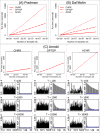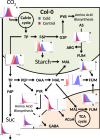Flux sampling is a powerful tool to study metabolism under changing environmental conditions
- PMID: 31482008
- PMCID: PMC6718391
- DOI: 10.1038/s41540-019-0109-0
Flux sampling is a powerful tool to study metabolism under changing environmental conditions
Abstract
The development of high-throughput 'omic techniques has sparked a rising interest in genome-scale metabolic models, with applications ranging from disease diagnostics to crop adaptation. Efficient and accurate methods are required to analyze large metabolic networks. Flux sampling can be used to explore the feasible flux solutions in metabolic networks by generating probability distributions of steady-state reaction fluxes. Unlike other methods, flux sampling can be used without assuming a particular cellular objective. We have undertaken a rigorous comparison of several sampling algorithms and concluded that the coordinate hit-and-run with rounding (CHRR) algorithm is the most efficient based on both run-time and multiple convergence diagnostics. We demonstrate the power of CHRR by using it to study the metabolic changes that underlie photosynthetic acclimation to cold of Arabidopsis thaliana plant leaves. In combination with experimental measurements, we show how the regulated interplay between diurnal starch and organic acid accumulation defines the plant acclimation process. We confirm fumarate accumulation as a requirement for cold acclimation and further predict γ-aminobutyric acid to have a key role in metabolic signaling under cold conditions. These results demonstrate how flux sampling can be used to analyze the feasible flux solutions across changing environmental conditions, whereas eliminating the need to make assumptions which introduce observer bias.
Keywords: Biochemical networks; Plant sciences.
Conflict of interest statement
Competing interestsThe authors declare no competing interests.
Figures




Similar articles
-
Metabolic flux from the chloroplast provides signals controlling photosynthetic acclimation to cold in Arabidopsis thaliana.Plant Cell Environ. 2021 Jan;44(1):171-185. doi: 10.1111/pce.13896. Epub 2020 Oct 7. Plant Cell Environ. 2021. PMID: 32981099
-
A comparison of Monte Carlo sampling methods for metabolic network models.PLoS One. 2020 Jul 1;15(7):e0235393. doi: 10.1371/journal.pone.0235393. eCollection 2020. PLoS One. 2020. PMID: 32609776 Free PMC article.
-
Integration of genome-scale modeling and transcript profiling reveals metabolic pathways underlying light and temperature acclimation in Arabidopsis.Plant Cell. 2013 Apr;25(4):1197-211. doi: 10.1105/tpc.112.108852. Epub 2013 Apr 23. Plant Cell. 2013. PMID: 23613196 Free PMC article.
-
Quantitative metabolic fluxes regulated by trans-omic networks.Biochem J. 2022 Mar 31;479(6):787-804. doi: 10.1042/BCJ20210596. Biochem J. 2022. PMID: 35356967 Free PMC article. Review.
-
Green pathways: Metabolic network analysis of plant systems.Metab Eng. 2016 Mar;34:1-24. doi: 10.1016/j.ymben.2015.12.001. Epub 2015 Dec 17. Metab Eng. 2016. PMID: 26704307 Review.
Cited by
-
Deciphering sphingolipid biosynthesis dynamics in Arabidopsis thaliana cell cultures: Quantitative analysis amid data variability.iScience. 2024 Aug 5;27(9):110675. doi: 10.1016/j.isci.2024.110675. eCollection 2024 Sep 20. iScience. 2024. PMID: 39297170 Free PMC article.
-
Deciphering rice metabolic flux reprograming under salinity stress via in silico metabolic modeling.Comput Struct Biotechnol J. 2020 Nov 20;18:3555-3566. doi: 10.1016/j.csbj.2020.11.023. eCollection 2020. Comput Struct Biotechnol J. 2020. PMID: 33304454 Free PMC article.
-
Implementation of a Clostridium luticellarii genome-scale model for upgrading syngas fermentations.Comput Struct Biotechnol J. 2025 Jan 22;27:649-660. doi: 10.1016/j.csbj.2025.01.013. eCollection 2025. Comput Struct Biotechnol J. 2025. PMID: 40046987 Free PMC article.
-
Validated In Silico Population Model of Escherichia coli.ACS Synth Biol. 2022 Aug 19;11(8):2672-2684. doi: 10.1021/acssynbio.2c00097. Epub 2022 Jul 8. ACS Synth Biol. 2022. PMID: 35801944 Free PMC article.
-
A structured evaluation of genome-scale constraint-based modeling tools for microbial consortia.PLoS Comput Biol. 2023 Aug 14;19(8):e1011363. doi: 10.1371/journal.pcbi.1011363. eCollection 2023 Aug. PLoS Comput Biol. 2023. PMID: 37578975 Free PMC article.
References
Publication types
MeSH terms
Grants and funding
LinkOut - more resources
Full Text Sources

